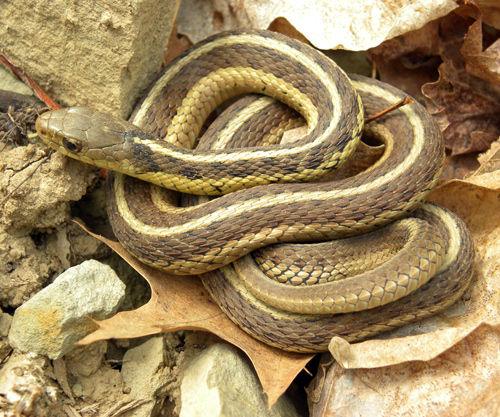The eastern gartersnake, also called the common gartersnake, is a smallish snake with a dark brown, brown or olive green body. The body can be flecked with white or light splotches and 3 light yellow stripes run the length of its body. Its belly is yellowish to greenish to yellow-brown. These snakes can be 16 to 41 inches long.
Eastern Gartersnakes range through most of the US. They are not found in the southwest except in California. They inhabit the southern edge of Canada. They are found all over Connecticut and are the state's most common snake.
Eastern gartersnakes live in a wide variety of habitats including moist areas, vacant lots, forest edges, farmlands and residential yards.
Mating season is in May in New England. Males emerge from hibernation first all at the same time, while females come out individually ,over a spread-out time period. Emerging males must bask in the sun to raise their body temperature so they can mate. Snakes cannot regulate their body temperature internally and must warm themselves in the sun. When the males warm up sufficiently, they seek out females. There are usually alot more males than females. Therefore a female snake tends to be mobbed by a pack of males all trying to mate with her. A ball of entwined snakes is the result, called a "mating ball". The female is trying to move along and all the males are trying to rub her with their chins and align their bodies next to hers. When the female is ready to mate, she will stop and raise her rear section slightly. The lucky male in the best position can maneuver his tail under hers and mate. Afterwards, the males disperse and go seeking another female. Females bear 3 to 85 live babies in August or September. They don't give them maternal care.
Eastern gartersnakes are actively foraging during the daytime. They hibernate over the winter and can den in burrows, rock crevices or under buildings, below the frost line. They often den communally and share winter dens with other gartersnakes and with other snake species such as Dekay's brownsnakes, redbelly snakes and smooth greensnakes.
Eastern gartersnakes eat earthworms, salamanders, frogs, toads, and small fish. They swallow their prey whole.
Eastern gartersnakes will try to avoid humans. They may produce musk and defecate when cornered and can bite if cornered or handled. Their bite is not particularly painful. They are not venomous.
Eastern gartersnakes are most often confused with the eastern ribbonsnakes.
